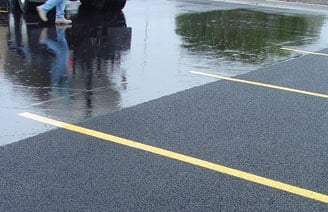Open Superior Angled Parking Efficiency with Professional Paving Solutions
Wiki Article
Discovering the Ecological Benefits of Warm Mix Asphalt
The usage of Hot Mix Asphalt in facilities tasks offers an engaging instance for sustainable growth and environmental stewardship. By delving right into the complex information of its production processes and the cutting-edge use recycled materials, a much deeper understanding arises of how this innovation surpasses plain surface applications. The environmental advantages of Warm Mix Asphalt prolong far beyond preliminary perceptions, supplying a nuanced perspective on just how this material can lead the method for a greener future.
Lowered Greenhouse Gas Emissions
Warm Mix Asphalt production uses a substantial decrease in greenhouse gas discharges contrasted to other pavement materials. The production process of Hot Mix Asphalt entails heating the mixture of aggregate and asphalt binder to high temperature levels. This process requires much less energy contrasted to the production of alternative pavement products, causing lower greenhouse gas discharges. Additionally, the usage of recycled materials in Warm Mix Asphalt even more adds to minimizing its ecological influence. By including reclaimed asphalt sidewalk and recycled asphalt tiles into the mix, the requirement for virgin products is reduced, bring about power cost savings and reduced discharges related to extraction and processing.Studies have shown that Warm Mix Asphalt sidewalks have a smaller carbon impact over their life cycle contrasted to other sidewalk options. The sturdiness and recyclability of Warm Mix Asphalt better improve its environmental advantages by lowering the requirement for frequent upkeep or substitute, consequently conserving sources and minimizing emissions connected with repair tasks.
Power Efficiency and Preservation
The production procedure of Warm Mix Asphalt not just decreases greenhouse gas discharges but likewise contributes dramatically to power effectiveness and preservation initiatives. Power performance is a key advantage of Warm Mix Asphalt production compared to other pavement kinds. The procedure involves warming the materials at heats to produce the asphalt mix, which requires much less energy than alternate approaches. Additionally, the capability to recycle and reuse asphalt pavement better improves power preservation. By integrating redeemed asphalt sidewalk (RAP) right into brand-new blends, the market saves power that would certainly have been needed to generate totally brand-new materials. Furthermore, the toughness of Hot Mix Asphalt reduces the regularity of upkeep and restoration, resulting in long-term energy financial savings. This long life minimizes the energy-intensive procedures associated with constant repair services and substitutes. On The Whole, Hot Mix Asphalt sticks out as an environmentally friendly choice that focuses on power efficiency and preservation throughout its lifecycle.Sustainable Pavement Solutions

One trick facet of sustainable pavement options is using recycled materials such as reclaimed asphalt sidewalk (RAP) and recycled asphalt shingles (RAS) By incorporating these materials right into the asphalt mixes, the need for virgin resources is lowered, resulting in reduced energy usage and greenhouse gas exhausts during production. In addition, the reuse of these products helps draw away waste from landfills, contributing to an extra round and lasting economy.
In addition, sustainable sidewalk services focus on enhancing pavement layout to boost efficiency and longevity. Strategies such as warm mix asphalt (WMA) and rock mastic asphalt (SMA) enhance the longevity and durability of pavements, decreasing the need for regular fixings and substitutes. By carrying out these cutting-edge methods, framework programmers can develop sidewalks that not only fulfill high-performance requirements but additionally lessen their environmental impact.
Minimized Environmental Influence
Hot mix asphalt, in specific, uses a number of advantages that add to decreasing the overall ecological footprint of road framework. One vital element is the recyclability of asphalt, which can be recycled multiple times without jeopardizing its top quality - Regrading.Additionally, the manufacturing of warm mix asphalt releases lower degrees of greenhouse gases contrasted to other pavement materials, making it a much more eco-friendly option. The energy effectiveness of asphalt plants has actually additionally improved over the years, causing lowered gas intake and lower emissions. Furthermore, the smooth surface of hot mix asphalt minimizes rolling resistance for lorries, causing lower fuel usage and reduced air contamination from automobile exhausts.
Payment to Environment Adjustment Reduction
Warm mix asphalt plays a crucial role in mitigating climate adjustment via its lasting residential or commercial properties and reduced environmental effect. One considerable contribution to climate change mitigation originates from the power performance of warm mix asphalt production. Compared to other sidewalk alternatives, the manufacturing process for warm mix asphalt consumes less energy and produces reduced levels of greenhouse gases, hence decreasing its general carbon impact.
Additionally, hot mix asphalt's ability to mirror sunshine, referred to as albedo, assists in decreasing urban warmth island impacts. By reducing heat absorption and retention, warm mix asphalt pavements can lower the need for cooling in metropolitan areas, consequently lowering greenhouse gas discharges connected with power consumption for cooling down functions.
Additionally, the durability and recyclability of warm mix asphalt even more boost its environment change reduction capabilities. Regrading. The lengthy life expectancy of asphalt pavements minimizes the need for constant repair work or substitutes, eventually lowering the carbon discharges connected to roadway upkeep tasks. The recyclability of asphalt products minimizes the need for virgin sources and lowers the ecological influence of pavement building and construction, aligning with sustainable techniques for environment change mitigation.
Verdict
Finally, the ecological advantages of Warm Mix Asphalt demonstrate its considerable payment to reducing greenhouse gas discharges, preserving power, and reducing environmental effect. This lasting sidewalk solution lines up with environment adjustment mitigation initiatives, promotes resource preservation, and boosts framework development. By utilizing recycled products, energy-efficient manufacturing processes, and resilient style, Warm Mix Asphalt plays an essential function in promoting an extra eco-friendly technique to framework construction.The production process of Hot Mix Asphalt involves heating the mix of aggregate and asphalt binder to high temperatures. By incorporating reclaimed asphalt pavement and recycled asphalt shingles right into the mix, the demand for virgin products is lowered, leading to power financial savings and lowered exhausts linked with removal and processing.
One secret aspect of sustainable sidewalk remedies is the usage of recycled materials such as reclaimed asphalt pavement (RAP) and recycled asphalt roof shingles (RAS) Methods such as warm mix regrading asphalt (WMA) and stone mastic asphalt (SMA) improve the resilience and resilience of sidewalks, lowering the requirement for regular repair work and replacements. Compared to various other pavement options, the production procedure for hot mix asphalt consumes much less power and releases lower levels of greenhouse gases, hence minimizing its overall carbon impact.
Report this wiki page